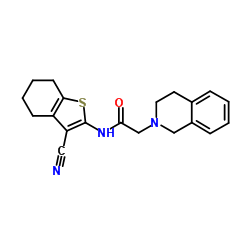1678416-08-4
| Name | N-(3-Cyano-4,5,6,7-tetrahydro-1-benzothiophen-2-yl)-2-(3,4-dihydro-2(1H)-isoquinolinyl)acetamide |
|---|---|
| Synonyms |
2(1H)-Isoquinolineacetamide, N-(3-cyano-4,5,6,7-tetrahydrobenzo[b]thien-2-yl)-3,4-dihydro-
N-(3-Cyano-4,5,6,7-tetrahydro-1-benzothiophen-2-yl)-2-(3,4-dihydro-2(1H)-isoquinolinyl)acetamide |
| Description | β-Amyloid (1-40), FAM-labeled is a FAM fluorescently-labelled β-Amyloid (1-40) peptide (λex= 492 nm and λem= 518 nm)[1]. |
|---|---|
| Related Catalog | |
| Target |
λex= 492 nm; λem= 518 nm |
| In Vitro | Apical-to-basolateral exchange across endothelial monolayer of fluorescent Aβ42 (FAM-labeled Human β-Amyloid (1-42) and Fluor™488-labeled β-Amyloid (1-42)) or scramble Aβ42 (FAM-labeled scrambled β-Amyloid (1-42)) (1-100 μM) is monitored in transendothelial electrical resistance (TEER) during cell monolayer’s formation over time (over 120 min in presence or absence of Aβ24). Human β-Amyloid (1-24) (1 μM) results in H-Aβ42 retention, thus reducing its efflux through the BBB and therefore preventing an efficient mechanism of Aβ42 clearance[1]. The in vitro BBB model is used to investigate the passage of FAM-labeled or 488-conjugated H-Aβ42 across the endothelial cell monolayer. The addition of fluorescently labeled H-Aβ42 (FAM-labeled Human β-Amyloid (1-42) or Fluor™ 488-labeled β-Amyloid (1-42)) to the apical side of cell inserts results in effective BBB crossing, FAM-labeled scrambled β-Amyloid (1-42) is not efficiently transcytosed. |
| References |
| Density | 1.3±0.1 g/cm3 |
|---|---|
| Boiling Point | 599.7±50.0 °C at 760 mmHg |
| Molecular Formula | C20H21N3OS |
| Molecular Weight | 351.465 |
| Flash Point | 316.5±30.1 °C |
| Exact Mass | 351.140533 |
| LogP | 4.45 |
| Vapour Pressure | 0.0±1.7 mmHg at 25°C |
| Index of Refraction | 1.661 |
